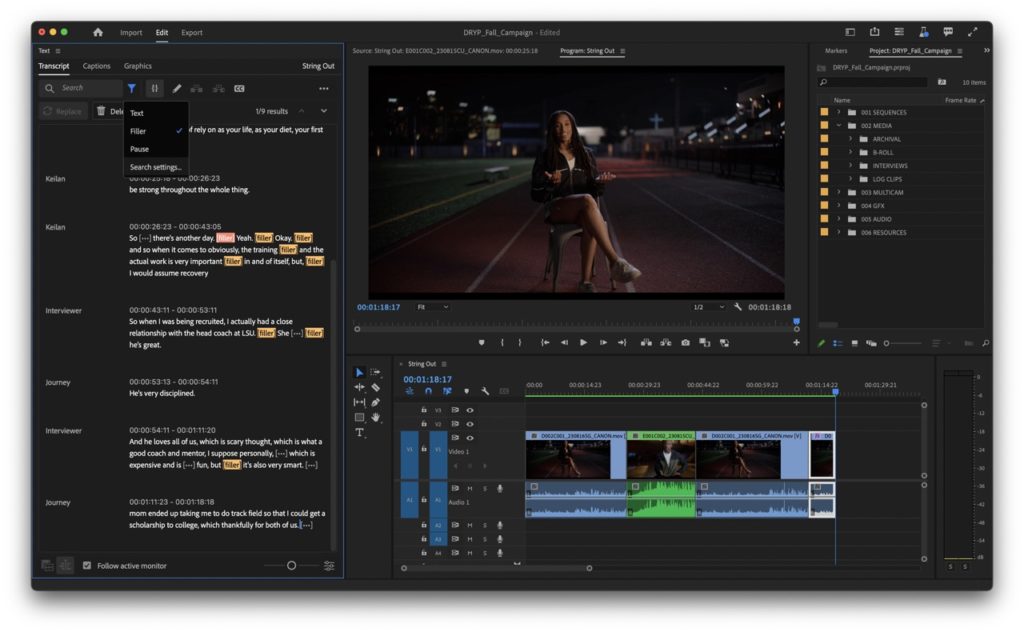With IBC 2023 ready to launch, Adobe has announced updates to their signature video applications, including some nice new features for Premiere Pro. These new features aren’t shipping in the release version just yet, which comes this fall, but they will roll out in the public beta for your own testing before shipping in the full version.
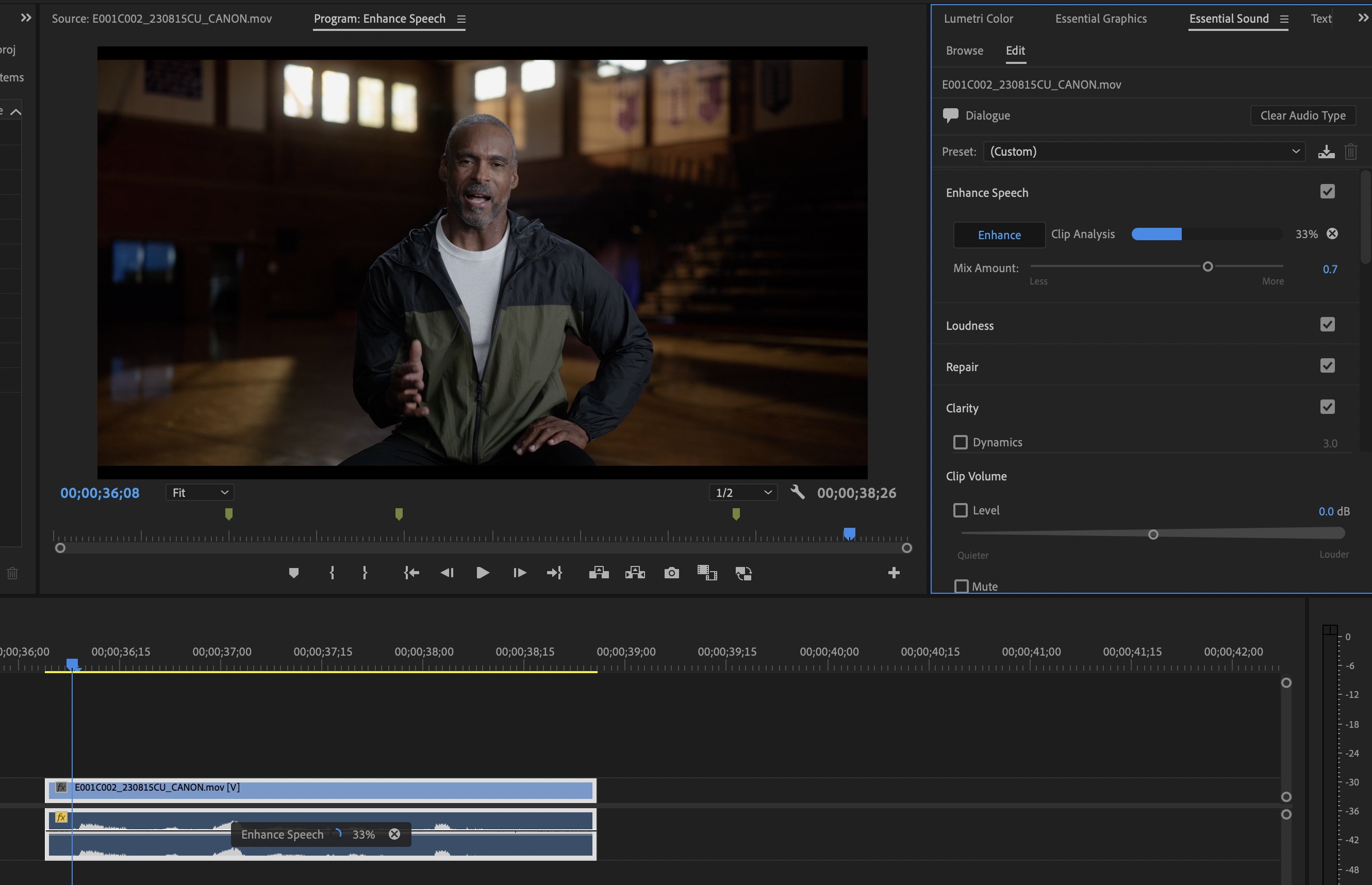
There are three headline features, and I’m going to run over them in order of what is, IMHO, their order of importance. This is my own personal order of importance so your order might be different than mine. But there are only three, so it’s not like our lives would be all the different.
“Performance Optimizations”
Okay, what exactly does “performance optimizations” mean? Aren’t there always performance optimizations in an update? Well certainly there better be, but one notable optimization in this update is the timeline performance has been increased by what Adobe says is a “massive 5x timeline performance improvement,” and while I think it’s hard to measure anything quite that specifically from an end-user standpoint, the timeline performance is noticeably better in this newest beta. Adobe achieves this by optimizing how fast the timeline will redraw as you are interacting with it. Timeline interactions are something we do repeatedly over and over, perhaps hundreds of thousands of times within a year of editing so smoother timeline interaction makes a huge difference in how an editing application feels.
I have felt a noticeable improvement in working in the latest beta, so kudos to Adobe for putting some engineering emphasis on something as “unsexy” as re-drawing in the speed of the timeline. I mean, how do you even market this because you can’t really show it in any truly interactive way? But you sure can feel it as you dig in.
Filler Word Detection (and removal) in Text-based Editing
Adobe currently holds the lead in text-based editing (you do know exactly what text-based editing is don’t you?) And some continued improvements in this version keep them in the lead. Filler word detection is going to be an incredible timesaver as it lets the text panel identify the uhs and umms within the dialogue. And then a one-click deletion of both filler words and pauses can really speed up the process.
I love this feature as it’s one of those things that has the potential to save him a lot of time cleaning up your interviews, chats and walk-and-talks. I would much rather have truly useful time-saving tools like this built into my editng applications then all of the film overlays and explosion effects in the world.
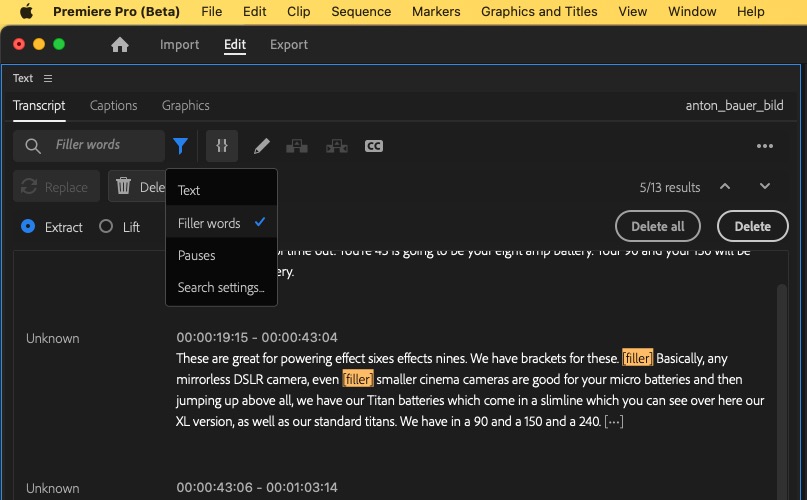
A new menu at the top of the Transcript tab of the Text panel will let you automatically see Filler words and pauses highlighted in the text panel. You can then choose to delete all of them at once.
This new menu also gives you the ability to search a specific word or phrase and then also delete all of those at once. So, while current “filler words” don’t include the dreaded you know and/or like you can search those out and delete them on your own.
Yes, this feature does Sherlock some of the third-party AI tools out there integrating with Adobe Premiere Pro, but they might still have usefulness as there aren’t really any settings yet to finesse what Adobe is doing here in the Text panel. You can’t tweak the tolerances of how Adobe cuts out these filler words and pauses, so they might require some finessing on the editor’s part (especially if the dialog is fast), but at least that gives the editor something to do!
Enhance Speech in the Essential Sound Panel
Remember the Enhance Speech option that has magically cleaned up audio in Adobe Podcasts for a while now? Well, that technology is making its way into the Essential Sound panel of Premiere Pro. I would argue this is where that technology was needed most across all of the Adobe products because you get way more bad audio shoved into your poorly recorded video projects than any other tool in the Adobe universe.
Once you tag a piece of audio as Dialog in the Essential Sound Panel, you’ll have an option to Enhance Speech. It’s relatively simple in that once you click the Analyze button, PPro will have to analyze the audio before it can be enhanced.
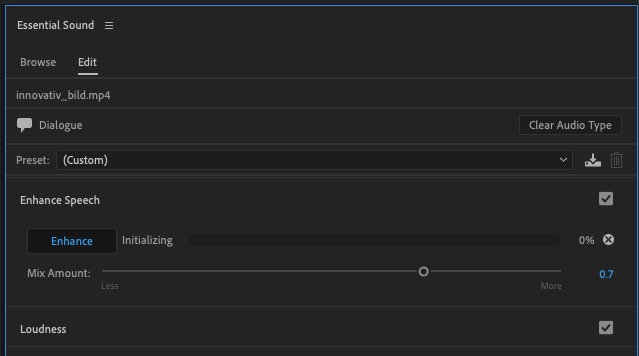
The engine for Enhance Speech has first to initialize before it can process. Processing is much faster than real-time, but it still takes some time. In my testing where I timed it, a 3-minute clip took about 40 seconds to process on an M2 Mac Studio (YMMV). You do get a nice indicator in the timeline of clips that are processing.
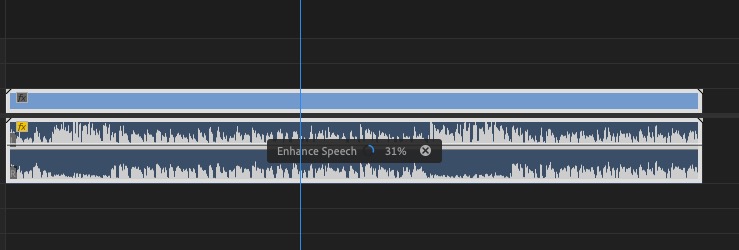
The results really are amazing, and the Mix Amount slider means that you can put just enough of the ambiance around a noisy clip into the final mix that it doesn’t sound overly artificial. It’s also worth noting that you can use the Enhance Speech option on clips that aren’t overly noisy, but they just weren’t recorded all that well. The results from this use case might sound a little bit artificial, but you can still process enhanced speech clips with other audio effects. It’s incredibly useful.
Adobe isn’t the first one with this technology in their video editing application, but it’s nice to get it where it is needed most. Enhance Speech Will be rolling out in the beta before its final release. And while the Enhance Speech is mainly targeted at noisy audio, I’m sure there are Youtubers everywhere who will run everything you can imagine through this new tool, and the comedy will be hilarious!
Color Settings in Lumetri Color panel
OK, those are my top three, but here is a fourth that will be incredibly important. Adobe is consolidating a number of color settings across the application into a new settings tab of the Lumetri Color panel. This ranges from preferences to project settings to sequence settings to specific clip settings, so there is a lot of data in a lot of settings that can be tweaked through this new tab.
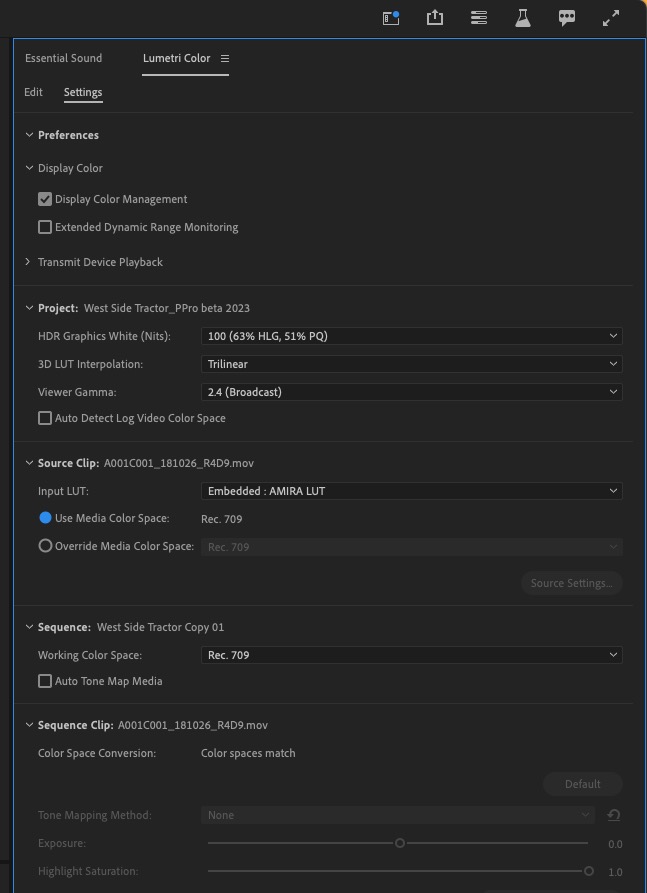
There is going to be a lot to unpack here in this new settings tab. While there are not a ton of things here that are brand new in this release, seeing all of these settings consolidated into one place and understanding the relationship of how one change may affect other things in the project will be helpful in understanding color management overall in Premiere Pro. Hopefully, a new gamma setting can alleviate a lot of the “quick time Gamma bug” problems that many users experience. Color management is a complex issue and takes work to understand so this is a place to begin.
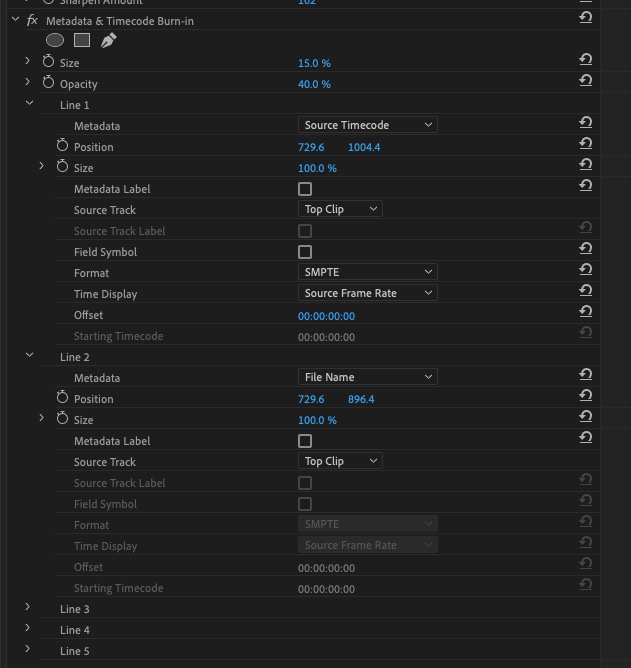
There are still other improvements across the application, many of them are requests from the community that include things such as new metadata and time code burn-in effect, project templates, direct export to Media Encoder and batch selection of markers just need a few. It would appear my single most hated feature in all of Premiere Pro is still there, but I’ve got my fingers crossed that that’s on the list for next time. My most loved feature is still there, so I’m thankful for that.
When this new version ships, it looks like it will be a full number upgrade, so you’ll have to upgrade your projects in order to use this new version. Downgrade the upgraded projects at your own risk.
But that’s not all Adobe has for IBC 2023! Here are the bullet-pointed feature lists. Expect these updates to ship in their full release later this fall.
Adobe After Effects
True 3D Workspace
After Effects introduces a true 3D workspace, opening the door to an entirely new way to design in motion. Add depth and dimension to compositions in a unified space with native import of 3D models. Image-Based Lighting realistically places models into a scene with complementary lighting and shadows using any image as a light source, making objects appear as though they naturally belong there. Beautiful 3D motion graphics are generated using an advanced 3D renderer, with the fast performance, high-quality antialiasing, and fantastic transparency. A unique way to combine 2D and 3D in a composition has also been added. Effects that reference another layer, such as Displacement Map, Vector Blur, or Calculations, can use a 3D model layer as a source to create highly stylized renders.
AI-Powered Roto Brush
Hard-to-isolate objects such as overlapping limbs, hair, and transparencies are separated from their background with ease thanks to an all-new AI model in the popular Roto Brush tool. With this addition, editors, motion designers, and VFX artists can shave off hours of tedious rotoscoping work, enabling you to focus on the more creative aspects of your projects.
Frame.io
Frame.io Storage Connect

Introducing Frame.io Storage Connect, which accelerates collaboration and cuts costs for Enterprise customers needing solutions to scale profitably—allowing them to use the storage they already own, while maintaining full control of their assets. Storage Connect enables direct connection to AWS S3 storage with lightweight proxies available in Frame.io. Storage Connect will be available later this year for Frame.io Enterprise customers.
Comparison Viewer
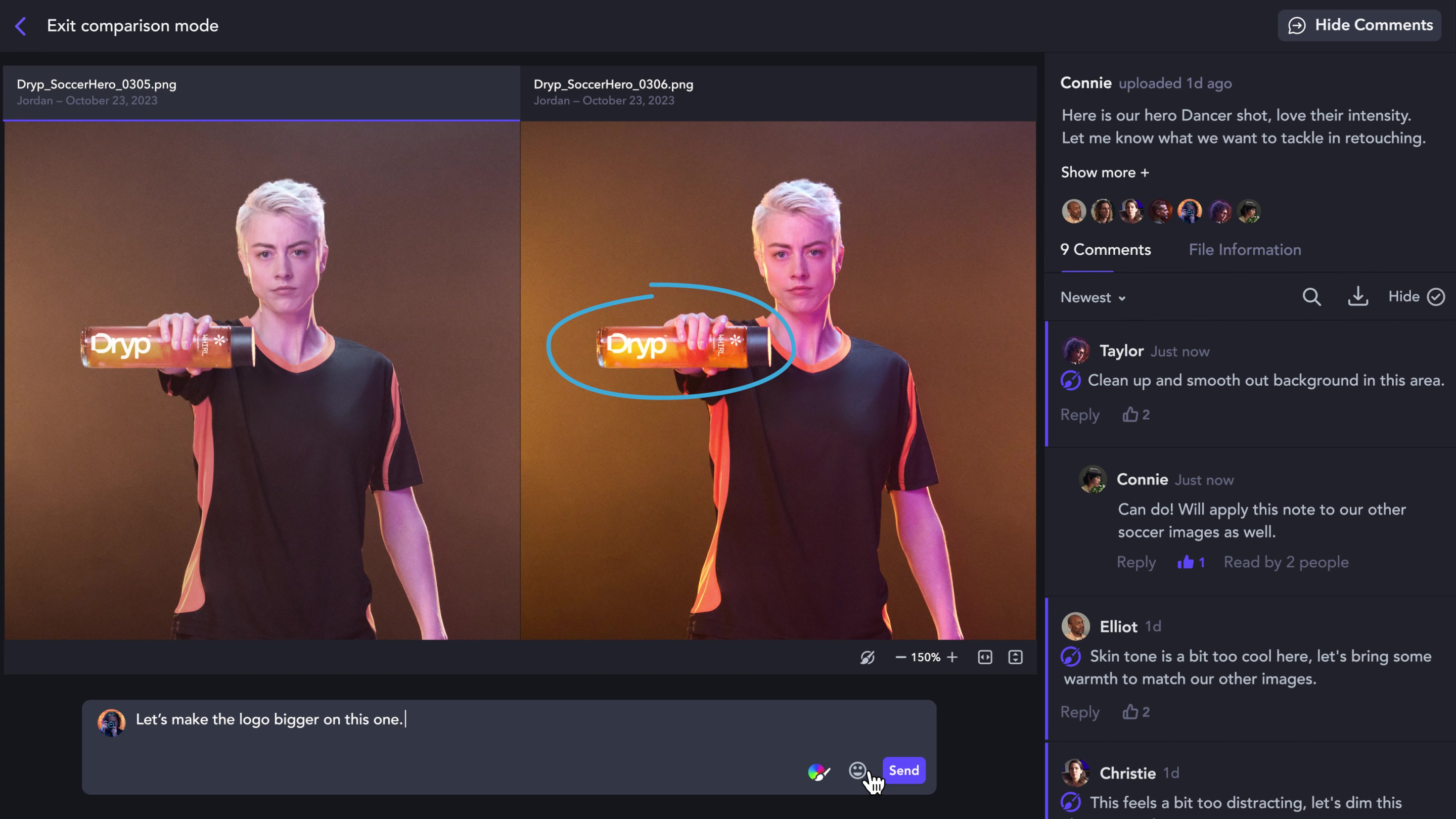
An increasing number of our customers create content for a vast array of purposes from broadcast to brands. That’s why we’ve refreshed our review and approval tools for creators who work with a wide range of assets and need to compare them.
The comparison viewer now supports viewing video, audio, photo, design file, and PDF assets side-by-side. Now, all Frame.io and Creative Cloud users can compare any two matching asset types with access to commenting and annotations, keeping you in the conversation as you carefully consider two different assets, or many versions of an asset or draft. This improvement to comparisons provides more nuanced review and approval capabilities for creatives and stakeholders who need to work faster and more efficiently.
Camera to Cloud Momentum
Supported on over 200+ camera systems through a vast network of integrations, Camera to Cloud is growing this year at IBC. Now with even more solutions for connecting your production to the cloud, we’re announcing five new Camera to Cloud connections for Frame.io and Creative Cloud customers.
Atomos has two new Camera to Cloud compatible devices, the new Ninja and Ninja Ultra. When paired with an Atomos CONNECT module, video teams can easily capture and automatically upload high-quality 10bit 4K H.265 assets to Frame.io after each take. The Ninja Ultra also unlocks duel-record ProRes RAW and HD proxy C2C capabilities for more advanced online/offline workflows.
Fujifilm’s new large-format mirrorless GFX-100ii (pronounced GFX-100 the second), allows photography and video teams to capture and upload 102MP RAW photos and up to 10bit 8K video clips remotely to Frame.io on a massive 55mm CMOS II HS sensor (11648 x 8736 pixel). The FUJIFILM GFX-100ii boasts a native integration, requiring no additional hardware for creators to leverage C2C on their next production.
New to the Camera to Cloud family is Accsoon, who unveils the SeeMo and SeeMo Pro devices. Both allow videographers, journalists, and news teams to use iPhones or iPads as professional video monitoring devices with features similar to those offered by Atomos, Blackmagic Design, or SmallHD.
The SeeMo, ideal for mirrorless cameras, attaches to cameras via HDMI. The heavier-duty SeeMo Pro attaches via HDMI or SDI and is perfect for ENG and mid-range cine cameras. With the new C2C integrations both allow you to monitor, record, and upload lightweight HD H.264 video clips from your connected iPhone or iPad directly to Frame.io.
Adobe Premiere Pro
Enhance Speech
Whether it’s due to scenarios like a poorly placed mic, excessive background noise or low-quality archive footage, poor audio can be very difficult to clean up. Enhance Speech uses AI to magically remove background noise and improve the quality of poorly recorded dialogue, making it sound as if it was recorded in a professional studio. You can also use the mix slider to incorporate some of the background noise to make it sound just right.
In addition, the new Audio Category Tagging uses AI to determine which clips contain dialogue, which contain music, and which are sound effects or ambient noise. When each audio clip is selected, the most relevant tools are automatically displayed. Together with Enhance Speech, editors can get valuable time back in their day by achieving professional-level audio quality with just a few clicks.
You can find Enhance Speech and Audio Category Tagging in the Essential Sound panel. Both features process in the background so you can keep working without skipping a beat.
Text-Based Editing Improvements
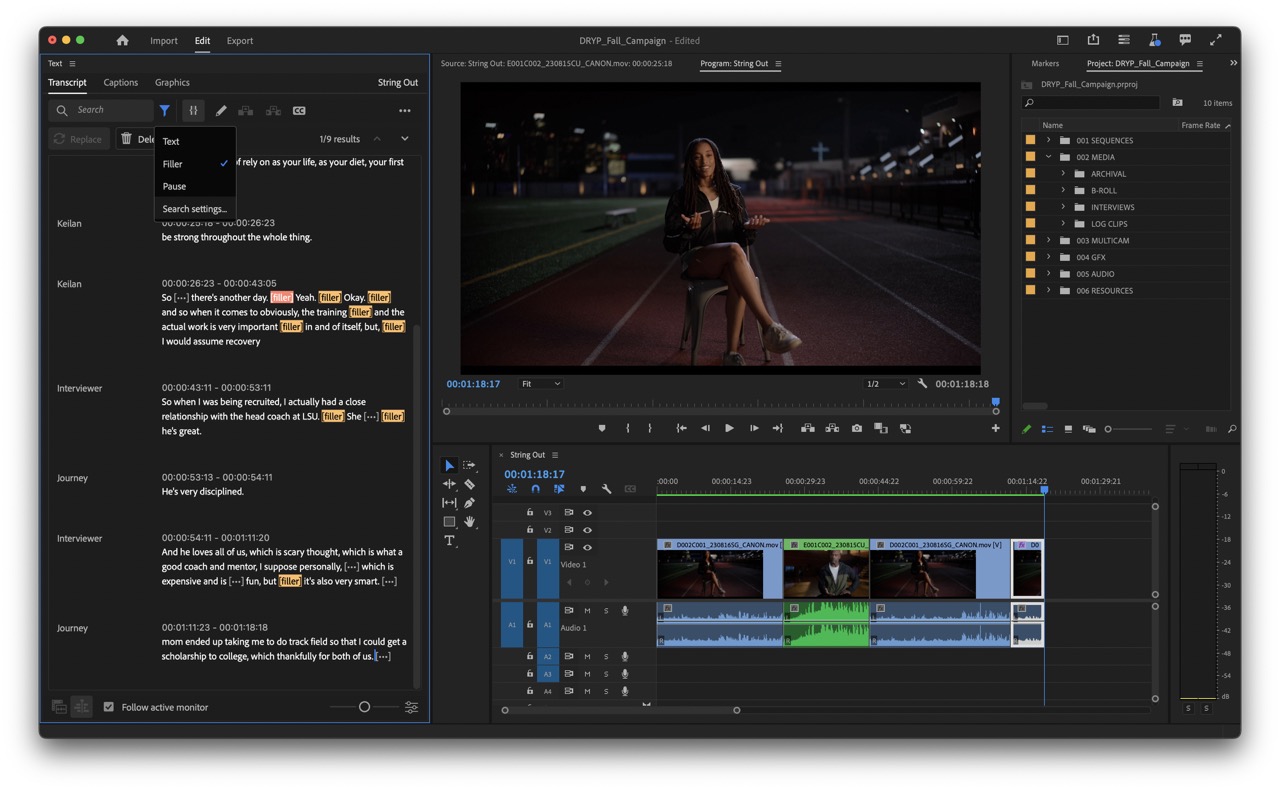
Premiere Pro introduced Text-Based Editing earlier this year to help make creating rough cuts as simple as copying and pasting text. We’re proud that Text-Based Editing has been recognized with several industry innovation awards—including the prestigious HPA Engineering Excellence Award. Today, it gets even better with enhancements based on top requests from the Adobe community.
Text-Based Editing now includes filler word detection to automatically identify “ums” and “uhs” in dialogue. You can quickly remove those filler words, pauses or any other unwanted dialogue in one step using bulk delete. These features can be accessed in the Transcript panel in Text- Based Editing workspace.
Performance Optimizations
The latest version of Premiere Pro includes massive 5x timeline performance improvements* for faster editing, and new tools such as the Effects Manager to help you find incompatible plug-ins to optimize system performance. Automatic project recovery helps ensure you can seamlessly pick-up right where you left off with in the event of a problem.
Color
New color preferences and improved tone mapping make it easier to get great color. Automatic Tone Mapping has been improved to include three new tone mapping methods. There are also new consolidated settings in the Lumetri Color panel as well as improved LUT management and relinking. Finally, you can ensure your colors look exactly as you expect in QuickTime Player by adjusting the new Viewer Gamma option.
Top Requests from the Community
Sometimes it’s the little things that count the most. That’s why you’ll find things like new project templates so you can get started faster, custom export locations, a new metadata and timecode burn-in effect, batch selection of markers and dozens of other minor, but mighty workflow enhancements that make a huge difference to editors using Premiere Pro all day. Each of these features were highly requested from the professional video community.

Filmtools
Filmmakers go-to destination for pre-production, production & post production equipment!
Shop Now